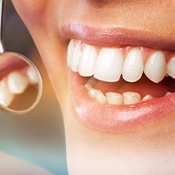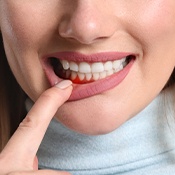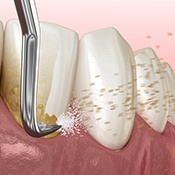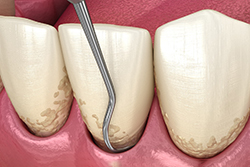Periodontal Therapy – Syracuse, NY
Fight Gum Disease Today for a Healthy Tomorrow

What is Periodontal Disease?

Gum disease (also referred to as periodontal disease), a chronic inflammation and infection of the gums and surrounding tissue, is the major cause of about 70% of adult tooth loss, affecting three out of four people at some point in their lives. In its earlier stages, gum disease can be treated, however if it persists, it can cause permanent tissue damage, jawbone deterioration, and even tooth loss.
The Common Symptoms of Periodontal Disease

Because gum disease has a better chance of being completely reversed if it’s caught early on, it’s important to know and recognize these common warning signs:
Periodontal Therapy Options
Dr. Craybas, working closely with our professional dental hygienists, will design a personalized program for you to help prevent periodontal disease from developing or to minimize the negative effects of the disease that already exist. One of the gum disease treatment options we have to offer is called scaling and root planing. This service involves scaling the smile to remove any plaque buildup from above, on, and beneath your gumline. Next, we will reach under your gums to smooth out your tooth roots, making it harder for bacteria to collect and cause infection.
We also offer antibiotic therapy, where we will simply prescribe you medication that you can take orally. These antibiotics will fight the bacteria causing inflammation in your gums. This solution is often used in tandem with scaling and root planing to effectively fight off infection.
Scaling & Root Planing

In many cases of gum disease, scaling and root planing are absolutely essential to rescue teeth. Without these tandem procedures, teeth can become loose and come out entirely. In other words, if Dr. Craybas recommends scaling and root planing, we only want to save your smile and spare you from having to replace teeth. If you have any questions about these treatments, we invite you to ask us! We’ll be happy to explain these advanced services and get your smile back on the path to full health.
Do I Need Scaling & Root Planing?
If you have gingivitis, the first stage of gum disease, you can usually resolve the problem with thorough brushing and flossing at home as well as a routine cleaning appointment. However, more advanced stages of gum disease require scaling and root planning because the inflammation-causing bacteria make the gum tissue separate from teeth, creating deep pockets. These procedures clear out trapped plaque and bacteria, allowing the gum tissue to heal from the infection.
The Process of Scaling & Root Planing
Both scaling and root planing are considered non-surgical procedures, but your mouth will be numbed before we perform them. Sometimes called a “deep cleaning,” scaling entails scraping plaque off your teeth, both above and below the gums. Afterward, the exposed root surfaces, which are typically rough in texture, are made slick. This makes it much harder for gum disease to develop there in the future because plaque can’t attach to the smooth surface.
Aftercare Tips for Scaling & Root Planing
For a couple hours following your appointment, your mouth will be numb, which means you shouldn’t eat anything until feeling returns to avoid accidentally biting your cheeks or tongue. You should rinse your mouth with warm saltwater multiple times per day for several days after treatment as well to further help fight inflammation and promote healing.
How to Prevent Periodontal Disease at Home
Since bacterial plaque, a sticky, colorless film that constantly forms on the teeth, is recognized as the primary cause of gum disease, regular dental hygiene visits are imperative to remove this causative factor. When plaque calcifies in your mouth into calculus, the periodontal disease process is well on its way. There are many other contributing factors to periodontal disease, including heredity, smoking, poor nutrition, stress and other diseases that interfere with the body’s immune system, which are sometimes more difficult to control.
Thankfully, you can lower your risk of this problem dramatically by practicing a good oral healthcare routine. In addition to visiting our office for regular checkups, you should brush your teeth twice a day for two minutes each session. Also, flossing will remove plaque and food debris from in between your teeth to keep your gums clean. You can even add a nonalcoholic mouthwash to your routine for an extra layer of cleaning.
If you have any questions, or if you’ve noticed any of the common signs and symptoms, contact our office right away!
